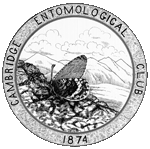
| January 2008: Psyche has a new publisher, Hindawi Publishing, and is accepting submissions |
Article beginning on page 343.
Psyche 3:343, 1880.
Full text (searchable PDF)
Durable link: http://psyche.entclub.org/3/3-343.html
The following unprocessed text is extracted from the PDF file, and is likely to be both incomplete and full of errors. Please consult the PDF file for the complete article.
PSYCHE.
CAMBRIDGE. MASS., MAY 1882.
-
Ciiww~~im~io~~, e.rcflftftges and editors' coy ies shonfd be addressed to EDITORS OF PSYCHE, Cam- firidgt, Mass. Commrkrations for pnWcelim ii I'STCHE #msi he property avfhei~timfcd, ami NO aiteuy- ~aott-s articles will b~ pviblixhed.
Editors ad contributors ore only rfspifftfihh for Works oil subjects not related to nttiimoIogy viU lid he mrimed J'M PSYCHE.
For raffs of ~#lm/n/tioft wd of ftdwriisi~~f~ sr~ ff dverttswff colu/mns.
CORRESPONDENCE.
BARON C. R. Osten Sacken, in a letter dat- ed at Heidelburg, 9 June 1882, calls attention to observations which he made many years ago, during his residence in Washington. D. C.. and which are similar to those record- ed bv Mr. W : Trelease in the February [IU- mero of PSYCHE. in an article entitled -.Un- usual care of ants for aphides."
Baron Osten Sacken has obligingly
furnished the following translation of a short article on the subject. which he published in the Stefther E-vioinohi~ac/;c Zeifanp, in 1862 {p, 127-128).
Huber made the observation that certain
ants erect a kind of shelter for the aphides which they use as milch cows, fastening it to the twig or stem upon which these plant- suckers are living. I do not remember the details of his observations, and have no copy of his work within reach. As far as I know. the observation has not been repeated since; at least when Kirby and Spcnce speak of it. it is evidently on Hnher's authority. 1 hope. for this reason. that two similar observations. which I made in the United Stated. may he of some scientific interest.
On a horizontnl twig of a juniper ('y. vi/-- finihun), ahout live feet from the ground. I observed a colony of a species of Lacthus. A emall reddish ant with fi brown abdomen was diligently working at a tube-bhaped
structure of a w(t, grayish brown! felt-like material, enclosing the twig in a kind of sheath. The material probably consisted of short fibres of Iiber closeiy packed together : it had a pitchy smell, burnt well, the smoke having the same smell. but stronger. The structure was about an inch long and one- third of an inch in diameter.
The second case observed by me was near
the Berkeley Springs, in Virginia. A black ant had built a globular structure of a sand! ma- terial, of about an inch and a half in diameter, around the stem of an Asclefiaf, which was closely packed with aphides. Although the sand was sufficiently mixed with clay to have the necessary consistence. and although sev- eral leaf-stalks served as supports, the struc- ture was so brittle that I did not succeed in bringing it home. .
XYLOCOPA AND MEGACHILE CUTTING
FLOWERS,
Miss Mary Esther Murtfeldt, of Kirkwood. Mo.. writes,. 22 June 1882. " I have repeated- 1.v verified your observations on 'å´XyJawfi perforating a corolla tube' in no. 93.
This great bee is n serious nuisance in our flower garden. It ie especially destructive to the delicate blossom-; nf Plumbqu cifpeiisis. which are mlver-hhaped with long. slender tuhei . I have seen n single insect slit up. in the manner you describe, as many iih fifty blossoms in about leu minutes. very soon ruining the appearance of the plant. It also splits the tubes of the hlosscmis of the hone!- suckles in the same wn?.
We are alho much annoved by the deprcda- tiom of ft Megackile which seems to have a very refined color-sense, cutting the lining for its cells from our choicest and most delicately tinted flowers, being very partial to pink, lavender and pale blues and purples, while it seldom or never touches scarlet or yellow. Pininhagot. and pink gernniiitns are m!nctinier- :tlmo<t dcslro+vi'd 1 ) ~ it.''
================================================================================
Volume 3 table of contents